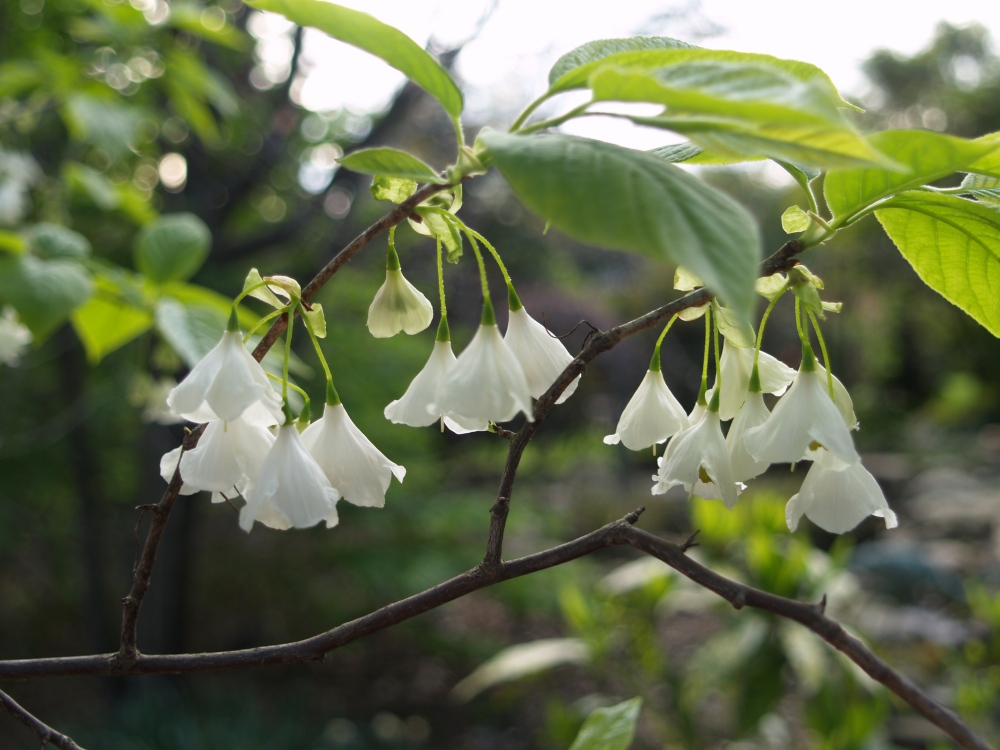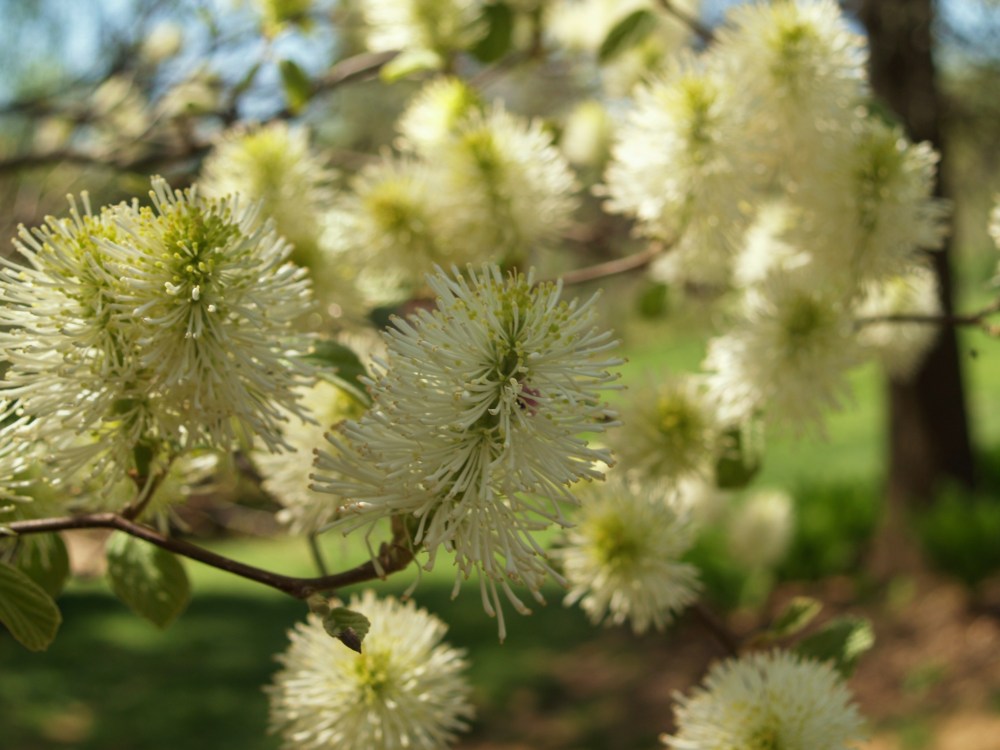There are many more flowers this year on the Carolina silverbell (Halesia carolina, below). I don’t see any reason that warm winter temperatures would have resulted in more blooms. I don’t expect that the buds are killed off in a normal winter, so it’s more likely that some weather phenomena at the time the flower buds were formed last year resulted in the abundant blooms. In any case, there are more flowers this spring, which is nothing to complain about.
The silverbell is not commonly found in gardens, but that doesn’t make it rare, just uncommon and probably under appreciated. It is native to woodlands of the southeastern United States, in particular along streams and on wooded mountain slopes. In my garden I’ve closely duplicated these understory conditions, and the silverbell grows tall and slender so that it’s clearly visible from the kitchen window of my home. In its early years I wondered what the fuss was about, since its flowers were sparse, but in recent years I’ve become quite enamored with the tree.
The bell-like blooms hang in clusters along the length of year old branches for ten days. By good fortune, this year the flowers are a few weeks early and temperatures have been cool, so the blooms will persist for another week longer. When temperatures are warm the flowers fade quickly, turning to the texture of tissue paper one day, then dropping and disappearing the next. For the remainder of the year the silverbell is unremarkable, but then so many other trees are not so lovely for these few glorious weeks.
For inexplicable reasons, fothergilla (Fothergilla major, above) has not gained more popularity. It’s native to similar geographic regions as the silverbell, and is similarly scarce in gardens. The most common fothergilla (Fothergilla gardenii’ Mt. Airy’) is carried by many garden centers, but despite splendid white bottlebrush blooms in the peak of the spring garden season it has not gained favor. In my garden I’ve found it to be care free, without insect or disease problems. After flowering, the foliage is quite agreeable, and autumn color is frequently a stunning orange or scarlet. I’ve planted many viburnums and lilacs, and I will attest that fothergilla is equally deserving of a spot in the garden.
The red bottlebrush buckeye (Aesculus pavia, above) is a small multi trunked tree or large bush that is probably a bit large for small gardens. In April its red flowers stand erect above the handsome, compound leaves, and though the blooms are not showy from a distance this is one of my favorite spring shrubs. The red buckeye performs well in deep shade, and in my garden it is planted beneath a wide spreading black gum so that the soil is constantly dry. In ten days of hundred degree temperatures last summer it looked a bit resentful and slightly off color, but even suffering my neglect to water it the buckeye recovered without ill effect.
In the deep shade of this same black gum I’ve planted a small grove of sweetshrubs (Calycanthus floridus, above) that perform exceptionally well. This grouping is planted at the border of the garden, far off the stone path, but I rarely pass this section in the spring without straying from the path to catch a glimpse of the unusual, red-brown, fragrant blooms. These are not flowers that will be favored by lovers of masses of petunias and impatiens, but they are well suited to the ramble-along-and-stick-your-nose-into-everything gardener. That’s me!
The red flowering sweetshrub is most common (though not commonplace), and it flowers ten days earlier than the yellow flowered variety in my garden. This could possibly be explained that the yellow is slightly more into the sun, but I would expect that the warming of the sun would cause it to flower a little earlier, not later. I lusted after the yellow variety for a number of years before finally planting one, and now I find that I prefer the red. I’m certain that there’s a lesson to be learned in there somewhere, but I’m a slow learner, and in any case, both yellow and red are marvelous.
I have a Fothergilla ‘Mt. Airy’ in my garden and love it! The fall color is spectacular every year, and appreciate that it’s native. Will be adding more to the garden this year.
A year ago my fothergilla flowered and faded quickly so I didn’t see it until the blooms were almost gone. It’s the only flowering plant on the side of the garden that faces my neighbor’s house, so I don’t get around to that end as often. This year there are more flowers, and with cool temperatures they’re hanging around longer. Wonderful!
Hi Dave,
Looks like I will be replacing my lavendar twist weeping redbud. There is not a bud on it… So very sad, but will not try another redbud of any species from here on out since my friends have all sorts of troubles with theres too…
My knock out roses, red and yellow are the best that they have ever been with this cooler weather again in SC. Also, the encore azalea is better than it has ever been along with the azalea’s in general throughout the yard. I wonder if the systemic (Bayer) has made the difference in the azaleas since they never have looked so well and budded so heavy that the encore was hanging down from the weight!
I may have to try one of those Fothergilla in my yard, they look beautiful if they would do well here in the heat…
Have a great rest of afternoon and evening!
Sorry about your redbud. North Carolina nursery grower Tony Avent says that he doesn’t give up on a plant until he’s killed it three times. I’ve killed so many plants over the years I barely give it a thought.
The fothergilla should work well for you. It’s native to all parts of the Carolinas. The best one for you will be ‘Mt. Airy’. Give it a try, and have a great spring.
Have you discussed hydrangeas lately? I live in Northern Montgomery County and my hydrangeas looked beaufiul a few weeks ago with lots of new leaves. But the frost got to them and now all those leaves are brown. Should I remove them? Should I cut the stems down to the new growth that is emerging now? I need some advice!
My hydrangeas miraculously escaped damage in the recent freezes, but for others less fortunate the new growth will indicate the point to which the stems should be cut back. When new growth starts again, cut the stem back to just above the new leaves. The stems of many hydrangeas are soft wooded, so they are susceptible to late frost damage, and of course it doesn’t help when they leaf out a month early. Many flower buds will be lost when they’re pruned, but new reblooming varieties like Endless Summer will flower on new growth.
Thank you so much for your quick response! This is exactly the advice I needed. I appreciate your help and will follow your blog from now on.
Great articles Dave, thanks for posting them!
I’m in south central PA and while I love the fothergillas, they do not flourish in my neutral soil. Rabbits like to eat the stems and buds as well. =(
The rabbit population in our neighborhood has exploded in the past few years. Now, I see more of them than deer, and there are plenty of deer. I’ve been fortunate to have had little trouble with the rabbits. Perhaps the deer spray discourages them.